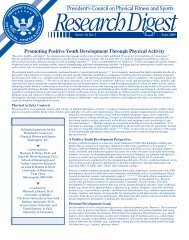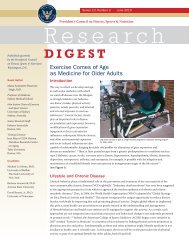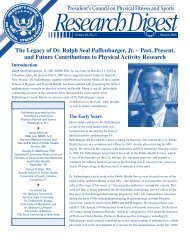Combining the U.S. Dietary Guidelines and Physical Activity
Combining the U.S. Dietary Guidelines and Physical Activity
Combining the U.S. Dietary Guidelines and Physical Activity
You also want an ePaper? Increase the reach of your titles
YUMPU automatically turns print PDFs into web optimized ePapers that Google loves.
Series 13, Number 1 June 2012<br />
Published quarterly<br />
by <strong>the</strong> President’s Council<br />
on Fitness, Sports & Nutrition<br />
Rockville, MD<br />
Corresponding Author<br />
Linda Van Horn, PhD, RD<br />
Northwestern University,<br />
Feinberg School of Medicine<br />
Department of Preventive<br />
Medicine<br />
Co-editors<br />
David Bassett, Jr., PhD<br />
University of Tennessee<br />
Michael La Monte, PhD<br />
University of Buffalo<br />
The State University of<br />
New York<br />
Diane Wiese-Bjornstal, PhD<br />
University of Minnesota<br />
Stella Volpe, PhD, RD, LD/N,<br />
FACSM<br />
Drexel University<br />
Jeffrey Mechanick, MD<br />
The Mount Sinai Medical Center<br />
President’s Council on Fitness, Sports & Nutrition<br />
Research<br />
DIGEST<br />
<strong>Combining</strong> <strong>the</strong> U.S. <strong>Dietary</strong> <strong>Guidelines</strong><br />
<strong>and</strong> <strong>Physical</strong> <strong>Activity</strong> <strong>Guidelines</strong> to Achieve<br />
a Healthy Lifestyle<br />
Abstract<br />
The 2010 U.S. <strong>Dietary</strong> <strong>Guidelines</strong> for<br />
Americans represent <strong>the</strong> translational<br />
recommendations derived from <strong>the</strong><br />
2010 U.S. <strong>Dietary</strong> <strong>Guidelines</strong> Advisory<br />
Committee report. This reflects <strong>the</strong><br />
work of a panel of 13 experts in various<br />
aspects of nutrition that included one<br />
member who also served on <strong>the</strong><br />
2008 <strong>Physical</strong> <strong>Activity</strong> <strong>Guidelines</strong> for<br />
Americans committee. Toge<strong>the</strong>r <strong>the</strong>y<br />
reviewed <strong>the</strong> literature <strong>and</strong>, with <strong>the</strong><br />
guidance of <strong>the</strong> Nutrition Evidence<br />
Library, systematically evaluated, “The 2010 U.S. <strong>Dietary</strong> <strong>Guidelines</strong> offer evidencebased<br />
recommendations for healthy eating with a<br />
ranked, <strong>and</strong> classified <strong>the</strong>se results to<br />
produce <strong>the</strong> most timely, evidencebased,<br />
<strong>and</strong> practical recommendations strong focus on <strong>the</strong> importance of weight control <strong>and</strong><br />
possible. First published in 1980, <strong>the</strong><br />
<strong>Dietary</strong> <strong>Guidelines</strong> for Americans are energy balance across all ages. Combined with <strong>the</strong><br />
updated <strong>and</strong> published every five years,<br />
<strong>Physical</strong> <strong>Activity</strong> <strong>Guidelines</strong>, <strong>the</strong>se two reports offer<br />
pending <strong>the</strong> panel’s decision that <strong>the</strong><br />
new evidence published since <strong>the</strong> last a wealth of science aimed at improving <strong>the</strong> health<br />
set of guidelines warrants a thorough<br />
review. The goals of <strong>the</strong> <strong>Dietary</strong> of <strong>the</strong> nation, but practical application is key to <strong>the</strong>ir<br />
<strong>Guidelines</strong> include defining a healthy<br />
success. This paper intends to offer some insights on<br />
diet, providing options for how to<br />
achieve it, promoting healthy choices, how best to achieve just that.”<br />
<strong>and</strong> generally increasing public<br />
awareness of <strong>the</strong> importance of good nutrition. The <strong>Dietary</strong> <strong>Guidelines</strong> provide <strong>the</strong> foundation for <strong>the</strong><br />
federal nutrition programs to assure a unified message for establishing policy that can be applied by<br />
educators, health professionals, <strong>and</strong> policy makers. When taken toge<strong>the</strong>r, <strong>the</strong> <strong>Dietary</strong> <strong>and</strong> <strong>Physical</strong> <strong>Activity</strong><br />
<strong>Guidelines</strong> can help provide <strong>the</strong> best lifestyle approach to balancing dietary energy intake <strong>and</strong> physical<br />
activity energy expenditure for purposes of controlling body weight. Underst<strong>and</strong>ing calorie balance is key<br />
to this process. The 2010 <strong>Dietary</strong> <strong>Guidelines</strong> emphasized <strong>the</strong> importance of preventing obesity, starting in<br />
childhood <strong>and</strong> also among pregnant women. By combining <strong>and</strong> applying <strong>the</strong>se principles, all individuals
across diverse age, gender, <strong>and</strong> ethnic groups should be<br />
able to practice <strong>and</strong> model healthy lifestyles for <strong>the</strong>mselves <strong>and</strong><br />
<strong>the</strong>ir families. The purpose of this paper is to combine<br />
<strong>and</strong> help translate <strong>the</strong>se guidelines into practical approaches<br />
aimed at advancing healthy lifestyles <strong>and</strong> improving public<br />
health outcomes.<br />
What Are <strong>the</strong> U.S. <strong>Dietary</strong> <strong>Guidelines</strong>?<br />
Beginning in 1980, <strong>the</strong> <strong>Dietary</strong> <strong>Guidelines</strong> for Americans have<br />
provided science-based recommendations for reducing risk of<br />
chronic diseases by promoting health through optimal dietary<br />
intake <strong>and</strong> regular physical activity. These <strong>Dietary</strong> <strong>Guidelines</strong> are<br />
typically focused on <strong>the</strong> healthy public over <strong>the</strong> age of two years,<br />
but <strong>the</strong> 2010 U.S. <strong>Dietary</strong> <strong>Guidelines</strong> Advisory Committee’s<br />
(DGAC) review of evidence overwhelmingly recognized<br />
that <strong>the</strong> majority of <strong>the</strong> American public is overweight or obese,<br />
including young children. There is an urgent need to halt <strong>and</strong><br />
reverse this obesity epidemic; thus, <strong>the</strong> DGAC report was written<br />
from this perspective. Also, evidence increasingly documents an<br />
association between nutrition <strong>and</strong> health beginning in utero,<br />
<strong>the</strong>reby justifying <strong>the</strong> importance of achieving energy balance<br />
throughout <strong>the</strong> lifecycle, including in pregnant women, children,<br />
<strong>and</strong> older individuals. The DGAC recommendations were written<br />
within that context.<br />
The <strong>Dietary</strong> <strong>Guidelines</strong> are updated every five years, based<br />
upon <strong>the</strong> existence of new research <strong>and</strong> compelling evidence that<br />
merits review <strong>and</strong> consideration. Compared to <strong>the</strong> 2005 dietary<br />
guidelines, <strong>the</strong> 2010 <strong>Dietary</strong> <strong>Guidelines</strong> Advisory Committee<br />
determined an abundance of new data had been published<br />
in <strong>the</strong> interim between reports, raising many new questions<br />
<strong>and</strong> requiring new consideration. The 2010 DGAC committed<br />
20 months to this process, resulting in a report submitted to <strong>the</strong><br />
secretaries of <strong>the</strong> U.S. Department of Agriculture (USDA) <strong>and</strong> <strong>the</strong><br />
U.S. Department of Health <strong>and</strong> Human Services (HHS). The<br />
report targeted recommendations that were considered essential<br />
to halting <strong>and</strong> reversing <strong>the</strong> obesity problem by implementing<br />
evidence-based, prevention-oriented strategies <strong>and</strong> approaches.<br />
Population groups of particular concern included children,<br />
pregnant <strong>and</strong> lactating women, <strong>and</strong> older adults. The data show<br />
that currently, children consume too many energy-dense,<br />
nutrient-poor calories <strong>and</strong> that <strong>the</strong> incidence of chronic diseases<br />
such as type 2 diabetes (T2D) have increased significantly over<br />
time [1]. Up to 50 percent of new cases of T2D occur in youth,<br />
<strong>and</strong> primary prevention of obesity could effectively address<br />
this problem. Likewise, <strong>the</strong> majority of women are overweight<br />
or obese at <strong>the</strong> time of conception <strong>and</strong> gain more than<br />
<strong>the</strong> recommended amount of weight during gestation [2].<br />
Fur<strong>the</strong>rmore, maternal diet quality influences <strong>the</strong> nutrient<br />
composition of breast milk <strong>and</strong> this, too, can result in increased<br />
risk of adiposity of <strong>the</strong> offspring [3]. Also, <strong>the</strong> population aged<br />
65 years <strong>and</strong> older is expected to double over <strong>the</strong> next 20 years,<br />
<strong>the</strong>reby increasing <strong>the</strong> number of adults with chronic conditions<br />
such as T2D, cardiovascular disease (CVD), hypertension (HTN),<br />
arthritis, <strong>and</strong> cancers that are all adversely affected by overweight<br />
<strong>and</strong> obesity [4].<br />
The U.S. <strong>Dietary</strong> <strong>Guidelines</strong> underlie federal nutrition education,<br />
research, <strong>and</strong> outreach programs <strong>and</strong> constitute <strong>the</strong> basis for<br />
nutrition assistance programs such as SNAP (formerly Food<br />
Stamps) <strong>and</strong> <strong>the</strong> National School Lunch <strong>and</strong> School Breakfast<br />
programs. The <strong>Dietary</strong> <strong>Guidelines</strong> work in t<strong>and</strong>em with o<strong>the</strong>r<br />
national programs, such as <strong>the</strong> inaugural 2008 <strong>Physical</strong> <strong>Activity</strong><br />
<strong>Guidelines</strong> for Americans released by HHS.<br />
The purpose of this report is threefold:<br />
• To summarize <strong>the</strong> evidence contributing to <strong>the</strong> U.S. <strong>Dietary</strong><br />
<strong>Guidelines</strong>, specifically related to <strong>the</strong> chapter on energy balance<br />
• To identify especially relevant aspects of <strong>the</strong> <strong>Dietary</strong> <strong>Guidelines</strong><br />
that intertwine with <strong>and</strong> evolve from <strong>the</strong> 2008 <strong>Physical</strong> <strong>Activity</strong><br />
<strong>Guidelines</strong> Advisory Committee (PAGAC) Report on <strong>Physical</strong><br />
<strong>Activity</strong> [5]<br />
• To provide practical considerations regarding effective strategies<br />
<strong>and</strong> approaches, including <strong>the</strong> common <strong>the</strong>me of calorie balance,<br />
that can have synergistic benefits on public health [5]<br />
Finally, some areas for future research <strong>and</strong> gaps in <strong>the</strong> literature<br />
are summarized.<br />
What Do <strong>the</strong> 2010 U.S. <strong>Dietary</strong> <strong>Guidelines</strong><br />
Recommend?<br />
Advances in science <strong>and</strong> data analyses have fostered new<br />
breakthroughs in documenting <strong>and</strong> identifying key dietary factors<br />
that will enhance overall nutrient composition. The 2010 U.S.<br />
DGAC advocated a nutrient-dense total diet approach that would<br />
meet nutrient needs without exceeding energy needs.<br />
Emphasis was on foods, portion size, <strong>and</strong> whole meal patterns,<br />
ra<strong>the</strong>r than a more traditional nutrient-specific approach. In<br />
Figure 1, dietary intakes are shown in comparison to<br />
recommended intake levels or limits. [6]<br />
Research Digest June 2012<br />
2
Figure 1.<br />
<strong>Dietary</strong> Intakes in Comparison to Recommended Intake Levels or Limits<br />
Eat more of <strong>the</strong>se:<br />
GOAL<br />
Whole grains 15%<br />
Vegetables 59%<br />
Fruits 42%<br />
Milk 52%<br />
Oils 61%<br />
Fiber 40%<br />
Potassium 56%<br />
Vitamin D 42%<br />
Calcium 75%<br />
Eat less of <strong>the</strong>se:<br />
LIMIT<br />
SoFAS 280%<br />
Added sugars 242%<br />
Solid fats 281%<br />
Refined grains 200%<br />
Sodium 229%<br />
Saturated fat 158%<br />
0% 50% 100% 150% 200% 250% 300%<br />
Intake as percent of goal or limit<br />
Note: Bars show average intakes for all individuals (ages 1 or 2 years or older) as a percent of <strong>the</strong> recommended intake level or limit.<br />
Recommended intakes for food groups <strong>and</strong> limits for refined grains, SoFAS, solid fats, <strong>and</strong> added sugars are based on <strong>the</strong> USDA 2000-calorie food<br />
patterns. Recommended intakes for fiber, potassium, vitamin D, <strong>and</strong> calcium are based on <strong>the</strong> highest AI for ages 14 to 70 years. Limits for sodium<br />
are based on <strong>the</strong> AI <strong>and</strong> for saturated fat on 7 percent of calories.<br />
Adapted from U.S. <strong>Dietary</strong> <strong>Guidelines</strong> Advisory Committee Report. Data source: What We Eat in America, National Health <strong>and</strong> Nutrition Examination<br />
Survey (WWEIA, NHANES) 2001–2004 or 2005–2006.<br />
The intakes of whole grains, vegetables, fruits, milk/dairy,<br />
<strong>and</strong> unsaturated fatty acids fall far short of <strong>the</strong> recommended<br />
intakes <strong>and</strong> this translates into inadequate intake of dietary fiber,<br />
potassium, vitamin D, <strong>and</strong> dietary calcium. These foods <strong>and</strong><br />
nutrients are essential in preventing chronic diseases such<br />
as T2D, CVD, <strong>and</strong> osteoporosis, among o<strong>the</strong>rs. Conversely, <strong>the</strong><br />
public consumes more than double <strong>the</strong> recommended limit of<br />
solid fats, added sugars, refined grains, sodium, <strong>and</strong> saturated fatty<br />
acids. These dietary behaviors contribute to development of risk<br />
for chronic diseases <strong>and</strong> often represent excess calorie intake<br />
as well.<br />
For <strong>the</strong> first time, evidence from studies that incorporated<br />
whole food patterns, such as <strong>the</strong> <strong>Dietary</strong> Approaches to Stopping<br />
Hypertension (DASH) [7, 8] <strong>and</strong> <strong>the</strong> Mediterranean diet [9], as<br />
well as vegetarian diets [10-13], documented benefits related to<br />
reduced risk of chronic diseases. On <strong>the</strong> basis of <strong>the</strong>se findings,<br />
<strong>the</strong> 2010 U.S. <strong>Dietary</strong> <strong>Guidelines</strong> Advisory Committee advocated<br />
a Total Diet approach that was rich in plant-based foods: fruits,<br />
vegetables, whole grains, <strong>and</strong> vegetable proteins. The USDA Food<br />
Patterns were fur<strong>the</strong>r developed to provide practical approaches<br />
to meeting <strong>the</strong> nutrient <strong>and</strong> calorie needs at different energy levels<br />
in order to satisfy various age/gender/activity needs across<br />
<strong>the</strong> population.<br />
Summary of Energy Balance <strong>and</strong> Weight Management<br />
The concept of energy balance is essential to weight control. It is<br />
<strong>the</strong> achievement of energy (calorie) intake that does not exceed<br />
total energy needs based on metabolic <strong>and</strong> activity expenditure.<br />
Put simply, it is energy intake that does not exceed energy<br />
output. Because of <strong>the</strong> obesity epidemic, <strong>the</strong>re is a recognized<br />
need to tip <strong>the</strong> energy balance toward reducing sedentary<br />
behavior <strong>and</strong> achieving an energy intake that is less than energy<br />
output, <strong>the</strong>reby enhancing <strong>the</strong> opportunity for weight loss among<br />
adults. Figure 1 illustrates <strong>the</strong> increasing number of calories<br />
consumed over <strong>the</strong> past four decades. From 1970–2008 <strong>the</strong> mean<br />
intake has increased over 600 calories/day, <strong>the</strong>reby explaining,<br />
Research Digest June 2012<br />
3
Figure 2.<br />
Average Daily Per Capita Calories from <strong>the</strong> U.S. Food Availability in 1970, 1990, <strong>and</strong> 2008,<br />
Adjusted for Spoilage <strong>and</strong> O<strong>the</strong>r Waste<br />
O<strong>the</strong>r dairy<br />
fats, 6<br />
Added fats<br />
<strong>and</strong> oils, 403<br />
Caloric<br />
sweeteners,<br />
402<br />
Dairy,<br />
155<br />
Flour <strong>and</strong> cereal<br />
products, 432<br />
1970<br />
2057 kcal<br />
Fruits, 71<br />
Vegetables,<br />
125<br />
Meat, eggs,<br />
<strong>and</strong> nuts, 463<br />
Added fats<br />
<strong>and</strong> oils, 446<br />
Caloric<br />
sweeteners,<br />
446<br />
O<strong>the</strong>r dairy<br />
fats, 15<br />
Flour <strong>and</strong> cereal<br />
products, 573<br />
1990<br />
2405 kcal<br />
Dairy,<br />
260<br />
Fruits, 85<br />
Vegetables,<br />
126<br />
Meat, eggs,<br />
<strong>and</strong> nuts, 453<br />
Added fats<br />
<strong>and</strong> oils, 616<br />
Caloric<br />
sweeteners,<br />
446<br />
O<strong>the</strong>r dairy<br />
fats, 25<br />
Dairy,<br />
257<br />
Flour <strong>and</strong> cereal<br />
products, 625<br />
2008<br />
2674 kcal<br />
Fruits, 87<br />
Vegetables,<br />
122<br />
Meat, eggs,<br />
<strong>and</strong> nuts, 482<br />
Adapted from <strong>the</strong> U.S. <strong>Dietary</strong> <strong>Guidelines</strong> Advisory Committee report. Data source: ERS Food Availability (Per Capita) Data System<br />
www.ers.usda.gov/Data/FoodConsumption/<br />
at least in part, <strong>the</strong> accompanying weight gain in this country.<br />
Figure 2 shows <strong>the</strong> average daily per capita calories from<br />
<strong>the</strong> U.S. food availability in 1970, 1990, <strong>and</strong> 2008, <strong>and</strong> illustrates<br />
<strong>the</strong> average calorie increase over this time [6].<br />
While <strong>the</strong>re are many factors that appear to contribute to <strong>the</strong>se<br />
extra calories, including larger portion sizes <strong>and</strong> more frequent<br />
fast food, snack food, <strong>and</strong> sugar-sweetened beverage intakes,<br />
<strong>the</strong> overarching goal to reduce overweight <strong>and</strong> enhance healthy<br />
lifestyle involves eating foods that are nutrient dense in order<br />
to meet nutrient needs without exceeding calorie needs.<br />
Because data show <strong>the</strong>re is a range of energy intake that<br />
accompanies energy output across different age <strong>and</strong> gender<br />
groups, <strong>the</strong> exact number of calories needed may vary across<br />
individuals. This is where physical activity can offer some<br />
flexibility. While physical activity without reduced energy intake<br />
is usually inadequate to produce <strong>and</strong> sustain substantial weight<br />
loss, <strong>the</strong> inclusion of regular physical activity was <strong>the</strong> primary<br />
recommendation of <strong>the</strong> PAGAC report, <strong>and</strong> this is fur<strong>the</strong>r<br />
reinforced by <strong>the</strong> U.S. <strong>Dietary</strong> <strong>Guidelines</strong> as well.<br />
Currently, grain-based desserts rank highest in mean energy<br />
intake among all persons constituting <strong>the</strong> U.S. population,<br />
followed by yeast breads, chicken <strong>and</strong> chicken dishes, soda,<br />
<strong>and</strong> pizza. Among boys ages 2–18 years, pizza, grain-based<br />
desserts, <strong>and</strong> sugar-sweetened soda represent <strong>the</strong> top three<br />
contributors [6]. Table 1 provides details by age for <strong>the</strong> top<br />
ten contributors. Table 1 illustrates <strong>the</strong> mean intake of energy<br />
<strong>and</strong> mean contribution (calories) of various foods among<br />
U.S. populations [6].<br />
<strong>Physical</strong> <strong>Activity</strong>: The Benefits of Counterbalance<br />
The DGAC report summarized <strong>the</strong> evidence regarding<br />
relationships between physical activity, body weight, <strong>and</strong> o<strong>the</strong>r<br />
health outcomes. There was strong, consistent evidence that<br />
people who are physically active are at reduced risk of developing<br />
obesity. Even among overweight or obese people, those who are<br />
more active have less risk of chronic disease, similar to that<br />
of normal weight people [5, 6].<br />
Similar to <strong>the</strong> DGAC, <strong>the</strong> PAGAC report was developed<br />
by 13 experts in physical activity who conducted a rigorous<br />
Research Digest June 2012<br />
4
systematic review of <strong>the</strong> evidence regarding <strong>the</strong> role of physical<br />
activity <strong>and</strong> health across different age, gender, <strong>and</strong> special needs<br />
groups. The DGAC report noted that <strong>the</strong> PAGAC report<br />
highlighted four distinct points that were especially relevant<br />
to underst<strong>and</strong>ing physical activity <strong>and</strong> energy balance.<br />
1. Achieving energy balance <strong>and</strong> a healthy weight depend on both<br />
energy intake <strong>and</strong> expenditure.<br />
2. The effect of caloric deficit on weight does not depend upon<br />
whe<strong>the</strong>r <strong>the</strong> deficit is produced by reducing intake, increasing<br />
expenditure, or both; however, research studies that include <strong>the</strong><br />
proportion of caloric deficit due to physical activity are rare.<br />
3. Bouts of moderate- to vigorous-intensity aerobic physical<br />
activity that contribute to meeting physical activity guidelines<br />
are not <strong>the</strong> only source of physical activity energy expenditure.<br />
Any movement throughout <strong>the</strong> day that replaces seated activity<br />
contributes to <strong>the</strong> totality of energy expenditure.<br />
4. Even among people at a healthy body weight, regular physical<br />
activity is required to maintain health <strong>and</strong> prevent disease.<br />
Regarding <strong>the</strong> last point, accumulating data document <strong>the</strong> fact<br />
that sedentary behavior is, in itself, a risk factor for all individuals<br />
[14, 15].<br />
Table 1.<br />
Mean Intake of Energy <strong>and</strong> Mean Contribution (kcal) of Various Foods Among U.S. Population, by Age,<br />
NHANES 2005–06<br />
All Age Age Age Age Age Age Age Age Age Age<br />
Persons 2–18 2–3 4–8 9–13 14–18 19+ 19–30 31–50 51–70 71+<br />
Sample Size 8549 3778 497 899 1047 1335 4771 1310 1537 1224 700<br />
Mean Intake of Energy (kcal) 2157 2027 1471 1802 2035 2427 2199 2407 2354 2020 1691<br />
Rank<br />
Food Group<br />
1 Grain-based desserts 138 138 68 136 145 157 138 128 145 134 141<br />
2 Yeast breads 129 114 65 98 109 151 134 120 128 149 141<br />
3 Chicken <strong>and</strong> chicken mixed dishes 121 113 59 92 122 143 123 154 141 97 67<br />
4 Soda/energy/sports drinks 114 118 23 50 105 226 112 186 121 73 33<br />
5 Pizza 98 136 47 95 128 213 86 129 108 48 21<br />
6 Alcoholic beverages 82 6 - - - 18 106 120 135 82 40<br />
7 Pasta <strong>and</strong> pasta dishes 81 91 86 97 101 78 78 92 81 75 50<br />
8 Mexican mixed dishes 80 63 26 40 76 86 85 146 99 48 9<br />
9 Beef <strong>and</strong> beef mixed dishes 64 43 19 23 42 70 71 81 78 58 55<br />
10 Dairy desserts 62 76 40 93 86 64 58 48 58 59 78<br />
Adapted from <strong>the</strong> National Cancer Institute (NCI). Food sources among U.S. populations, 2005–06. Risk factor monitoring <strong>and</strong> methods branch website.<br />
Applied Research Program. National Cancer Institute 2010a.<br />
Research Digest June 2012<br />
5
Amount of <strong>Physical</strong> <strong>Activity</strong> Needed to Maintain<br />
Healthy Body Weight<br />
As adopted from <strong>the</strong> PAGAC, <strong>the</strong> DGAC indicated that clear,<br />
consistent evidence reports that physical activity is beneficial for<br />
weight stability. The PAGAC recommended amounts<br />
are as follows:<br />
To Maintain Weight<br />
For Children/Adolescents: 60 minutes or more of moderateto-vigorous<br />
physical activity per day<br />
For Adults: 150–300 minutes per week of moderate-intensity<br />
physical activity or 75–150 minutes per week of vigorous intensity<br />
physical activity, or an equivalent combination of <strong>the</strong> two<br />
To Lose Weight<br />
For Overweight/Obese Adults (> 5% of body weight): Combine<br />
calorie restriction with at least 300 minutes per week of moderateintensity<br />
physical activity or 75–150 minutes of vigorous-intensity<br />
activity, or a combination of <strong>the</strong> two.<br />
To Avoid Regaining Weight After Weight Loss<br />
Accumulating scientific evidence documents <strong>the</strong> need to maintain<br />
efforts to avoid positive energy balance after weight loss [16].<br />
The available research indicates that prevention of substantial<br />
weight regain over six months or longer requires more than<br />
300 minutes per week of moderate-intensity or 150 minutes<br />
a week of vigorous-intensity aerobic activity, or an equivalent<br />
combination of <strong>the</strong> two, to avoid weight gain.<br />
Intriguing data are only now accumulating that help explain<br />
<strong>the</strong> possible contributors to <strong>the</strong> weight regain that so often<br />
accompanies a period of successful weight loss. For example, some<br />
investigators point to an “energy gap” that exists among previously<br />
overweight people, who require fewer calories to remain in<br />
energy balance than <strong>the</strong>ir same-weight counterparts who have<br />
never been overweight. The mechanisms <strong>and</strong> contributors to this<br />
phenomenon require fur<strong>the</strong>r exploration.<br />
Putting It All Toge<strong>the</strong>r: It’s All about Calories<br />
The U.S. <strong>Dietary</strong> <strong>Guidelines</strong> <strong>and</strong> <strong>the</strong> <strong>Physical</strong> <strong>Activity</strong> <strong>Guidelines</strong><br />
provide <strong>the</strong> best evidence-based recommendations regarding <strong>the</strong><br />
health benefits of a nutrient-dense diet <strong>and</strong> an active lifestyle.<br />
Such a dietary approach can help prevent cardiovascular disease,<br />
hypertension, T2D <strong>and</strong> certain cancers [7, 17–19]. Likewise,<br />
a physically active, minimally sedentary lifestyle has also been<br />
associated with reduced risk of developing <strong>the</strong>se same chronic<br />
diseases [20]. In both cases, <strong>the</strong> single most powerful approach<br />
to reducing risk of chronic disease is prevention or reduction of<br />
obesity. This involves eating fewer calories than an individual<br />
burns. While it is tempting to think that being more physically<br />
active allows unlimited or unrestricted food intake, <strong>the</strong> fact is<br />
that most people can easily eat more calories than <strong>the</strong>y can burn<br />
by doing physical activity <strong>and</strong> this is a major contributor to<br />
weight gain.<br />
As illustrated in Table 1, grain-based desserts are <strong>the</strong><br />
number one-ranked contributor of calories to <strong>the</strong> diet of <strong>the</strong><br />
U.S. population. This includes cake, cookies, pie, granola bars, etc.<br />
On average, people across all age groups eat 138 calories per day<br />
from such foods. These are energy- (calorie-) dense foods with few<br />
nutrients. Likewise, on average, people consume 114 calories from<br />
sugar-sweetened beverages that contribute few, if any nutrients.<br />
On average, people consume an estimated 98 calories per day<br />
from foods (like pizza) that are high in fat, salt, <strong>and</strong> refined<br />
carbohydrates <strong>and</strong> are inconsistent with <strong>the</strong> majority of <strong>the</strong><br />
<strong>Dietary</strong> <strong>Guidelines</strong> recommendations. Taken toge<strong>the</strong>r, <strong>the</strong>se foods<br />
contribute approximately 350 calories per day that, for many<br />
individuals, exceed <strong>the</strong> daily limits needed to lose excess weight or<br />
maintain ideal weight. People who wish to consume such foods on<br />
a regular basis <strong>and</strong> not gain weight should consider increasing<br />
physical activity beyond <strong>the</strong> PAG to accommodate <strong>the</strong> extra<br />
calorie intake. As recommended, adults need at least two hours<br />
<strong>and</strong> 30 minutes each week of aerobic physical activity at a<br />
moderate level OR one hour <strong>and</strong> 15 minutes each week of aerobic<br />
physical activity at a vigorous level. This represents, on average,<br />
between 85 <strong>and</strong> 95 calories per day of moderate to vigorous<br />
physical activity to maintain weight at current levels, but to lose<br />
weight, a deficit of approximately 500 calories per day is needed in<br />
order to lose about one pound per week. This formula will not<br />
achieve <strong>the</strong> same results for everyone since age, gender, <strong>and</strong><br />
current body weight will influence how many calories are burned<br />
per hour [21], but <strong>the</strong> principles provide context for recognizing<br />
<strong>the</strong> energy costs required for balancing intake <strong>and</strong> output. Table 2<br />
illustrates <strong>the</strong> caloric expenditure represented by various forms of<br />
physical activity based on an average man.<br />
How Many Calories Does <strong>Physical</strong> <strong>Activity</strong> Use?<br />
Energy (in <strong>the</strong> form of calories) is expended on <strong>the</strong> basis of<br />
<strong>the</strong> intensity (how vigorous) <strong>and</strong> <strong>the</strong> duration (how long) of an<br />
activity. The number of calories spent depends on <strong>the</strong> size, gender,<br />
age, <strong>and</strong> general health status of an individual. The following<br />
example was provided by <strong>the</strong> PAG:<br />
A 154-pound man who is 5' 10" tall will use up about <strong>the</strong> number<br />
of calories listed doing each activity below. Those who weigh more<br />
will use more calories, <strong>and</strong> those who weigh less will use fewer. The<br />
calorie values listed include both calories used by <strong>the</strong> activity <strong>and</strong><br />
<strong>the</strong> calories used for normal body functioning. Table 2 illustrates<br />
<strong>the</strong> number of estimated calories burned at different intensities<br />
of physical activity [5]. Recognizing <strong>the</strong> number of calories burned<br />
during various physical activities can help a person monitor <strong>the</strong>ir<br />
energy balance on a daily basis, while taking into consideration <strong>the</strong><br />
average recommendations provided by <strong>the</strong> national guidelines.<br />
Research Digest June 2012<br />
6
Table 2.<br />
Number of Estimated Calories Burned at Different Intensities of <strong>Physical</strong> <strong>Activity</strong><br />
<strong>Physical</strong> activities<br />
Approximate calories used by a 154-pound man<br />
Moderate physical activities In 60 minutes In 30 minutes<br />
Hiking 370 185<br />
Light gardening/yard work 330 165<br />
Dancing 330 165<br />
Golf (walking <strong>and</strong> carrying clubs) 330 165<br />
Bicycling (< 10 mi/hr) 290 145<br />
Walking (3.5 mi/hr) 280 140<br />
Weight training (general light workout) 220 110<br />
Stretching 180 90<br />
Vigorous physical activities In 60 minutes In 30 minutes<br />
Running/jogging (5 mi/hr) 590 295<br />
Bicycling (> 10 mi/hr) 590 295<br />
Swimming (slow, freestyle laps) 510 255<br />
Aerobics 480 240<br />
Walking (4.5 mi/hr) 460 230<br />
Heavy yard work (chopping wood) 440 220<br />
Weight lifting (vigorous effort) 440 220<br />
Basketball (vigorous) 440 220<br />
Adapted from USDA’s MyPlate.gov<br />
Research Digest June 2012<br />
7
Table 3.<br />
Comparison of Lower, Nutrient Dense vs. Higher, Empty Calorie Food Choices<br />
Food Total Empty Calories in Calories in Saturated Sodium<br />
calories calories solid fats added sugars fat (g) (mg)<br />
Apple pie, one crust (1/8 of 9" pie) 363 221 110 111 3 299<br />
Apple, medium 72 0 0 0 0 1<br />
French fries (1 small order of fast food) 271 117 117 0 3 164<br />
Baked potato, with peel 179 0 0 0 0 140<br />
(1 medium, 3") with 1 oz nonfat yogurt<br />
Potato chips (1 oz) 152 0 0 0 1 147<br />
Air popped popcorn (1 cup), 57 0 0 0 0 77<br />
with 1 TB parmesan cheese<br />
Peanut butter cheese crackers (1 oz) 171 42 28 14 3 231<br />
Rice cake, no salt (1 cake) 125 4 1 2 0 75<br />
with 1 TB peanut butter<br />
Cookie, chocolate s<strong>and</strong>wich type (2) 95 61 31 30 1 85<br />
Graham cracker (2 rectangles) 59 27 11 16 0 85<br />
Adapted from USDA’s SuperTracker website: www.choosemyplate.gov/SuperTracker/foodtracker.aspx<br />
Foods Lower in Calories<br />
To consume fewer calories each day, it is recommended that<br />
nutrient-poor (empty calorie) foods contributing solid fats <strong>and</strong><br />
added sugar be reduced or avoided in favor of foods that are<br />
nutrient-dense <strong>and</strong> lower in calories. In general, ounce for ounce,<br />
fruits, vegetables, <strong>and</strong> whole grain foods such as oatmeal,<br />
brown rice, quinoa, <strong>and</strong> whole grain breads, offer fewer calories<br />
per serving. These foods can also contribute satiety, or a sense<br />
of fullness, that can help to reduce hunger. For example,<br />
Table 3 illustrates some comparisons regarding lower versus<br />
higher calorie foods.<br />
Choosing foods that are higher in fiber <strong>and</strong> nutrients <strong>and</strong> lower<br />
in sugar <strong>and</strong> solid fats closely resembles <strong>the</strong> DASH diet that has<br />
been shown to be associated with reduced blood pressure <strong>and</strong> risk<br />
for T2D. When fur<strong>the</strong>r accompanied by weight loss, <strong>the</strong> benefits<br />
can be substantial <strong>and</strong> help to model <strong>the</strong> proper balance in eating<br />
<strong>and</strong> activity that should be instilled among healthy children to<br />
help prevent <strong>the</strong>m from becoming overweight or obese.<br />
Needs for Fur<strong>the</strong>r Research <strong>and</strong> Next Steps<br />
Both <strong>the</strong> DGAC <strong>and</strong> PAGAC reports contribute greatly to <strong>the</strong><br />
underst<strong>and</strong>ing of diet <strong>and</strong> activity needs for reducing risk for<br />
chronic disease. Both reports emphasize <strong>the</strong> critical need to halt<br />
<strong>and</strong> reverse <strong>the</strong> obesity epidemic with special emphasis on<br />
primary prevention, starting with children.<br />
However, both reports also point out major gaps in <strong>the</strong> evidence<br />
<strong>and</strong> <strong>the</strong> need for additional research to more fully <strong>and</strong> conclusively<br />
address <strong>and</strong> advance <strong>the</strong>se areas.<br />
Some key areas of needed research cited were:<br />
1. Well-controlled studies with adequate sample size <strong>and</strong><br />
prospective designs to characterize <strong>the</strong> associations between<br />
specific dietary factors <strong>and</strong> childhood adiposity.<br />
2. Studies testing interventions likely to improve energy balance<br />
in children at increased risk of childhood obesity, especially<br />
measuring dietary approaches to reduce energy density, total<br />
energy, dietary fat, <strong>and</strong> sugar-sweetened beverages, as well<br />
as enhancing intake of fruits <strong>and</strong> vegetables.<br />
Research Digest June 2012<br />
8
3. Document positive <strong>and</strong> negative impacts of environment<br />
on weight control.<br />
4. Research <strong>the</strong> effect of local <strong>and</strong> national food systems on<br />
dietary intake.<br />
5. Study o<strong>the</strong>r behaviors that might influence eating practices.<br />
6. Examine snacking behavior, meal frequency, <strong>and</strong> body weight.<br />
7. Conduct r<strong>and</strong>omized controlled trials that compare <strong>and</strong><br />
combine diet <strong>and</strong> physical activity patterns that influence<br />
weight control.<br />
8. Conduct studies on gestational weight gain <strong>and</strong> how to achieve<br />
appropriate levels.<br />
9. Improve pre-pregnancy BMI <strong>and</strong> gestational weight gain<br />
monitoring <strong>and</strong> surveillance in <strong>the</strong> U.S.<br />
10. Conduct longitudinal studies with adequate designs to<br />
fur<strong>the</strong>r examine <strong>the</strong> association between breastfeeding <strong>and</strong><br />
postpartum weight changes in mo<strong>the</strong>rs <strong>and</strong> offspring.<br />
11. Determine isocalorically how solid foods <strong>and</strong> liquids influence<br />
satiety <strong>and</strong> weight control long term.<br />
12. Study approaches to helping people underst<strong>and</strong> <strong>and</strong> apply<br />
<strong>the</strong> concept of energy balance on a daily basis.<br />
Some helpful websites include:<br />
MyPlate<br />
www.choosemyplate.gov/<br />
2008 U.S. <strong>Physical</strong> <strong>Activity</strong> <strong>Guidelines</strong> for Americans<br />
www.health.gov/paguidelines/report/<br />
www.health.gov/paguidelines/toolkit.aspx<br />
2010 U.S. <strong>Dietary</strong> <strong>Guidelines</strong> Advisory Report<br />
www.cnpp.usda.gov/DGAs2010-DGACReport.htm<br />
2010 U.S. <strong>Dietary</strong> <strong>Guidelines</strong><br />
www.cnpp.usda.gov/dietaryguidelines.htm<br />
These <strong>and</strong> o<strong>the</strong>r areas of research remain unexplored <strong>and</strong> data<br />
are badly needed in order to effectively succeed in reducing <strong>the</strong><br />
risk <strong>and</strong> incidence of overweight <strong>and</strong> obesity in this country.<br />
Overall, both diet <strong>and</strong> physical activity are important influences<br />
on health <strong>and</strong> risk for disease.<br />
There is an especially strong need to introduce effective<br />
strategies that can prevent <strong>the</strong> risk of developing obesity in<br />
children, in order to help reduce <strong>and</strong> reverse <strong>the</strong> disturbing trends<br />
of development of chronic disease at younger <strong>and</strong> younger ages.<br />
This requires partnership across government <strong>and</strong> private sectors,<br />
parents, <strong>and</strong> providers in order to take effect.<br />
Research Digest June 2012<br />
9
References<br />
1. Reedy J, Krebs-Smith SM. <strong>Dietary</strong> sources of energy, solid fats, <strong>and</strong><br />
added sugars among children <strong>and</strong> adolescents in <strong>the</strong> United States.<br />
J Am Diet Assoc 2010;110(10):1477–84.<br />
2. Institute of Medicine. Weight Gain During Pregnancy:<br />
Reexamining <strong>the</strong> <strong>Guidelines</strong>. Washington, DC: National Academies<br />
Press; 2009.<br />
3. Oken E, Gillman MW. Fetal origins of obesity. Obes Res<br />
2003;11(4):496–506.<br />
4. He W, Sengupta M, Velkoff V, DeBarros K. US Census Bureau<br />
Current Population Reports 65+ in <strong>the</strong> United States. Washington,<br />
DC: US Government Printing Office; 2005.<br />
5. US Department of Health <strong>and</strong> Human Services. <strong>Physical</strong> <strong>Activity</strong><br />
<strong>Guidelines</strong> for Americans. Washington, DC; 2008.<br />
6. US Department of Health <strong>and</strong> Human Services. Report of <strong>the</strong><br />
<strong>Dietary</strong> <strong>Guidelines</strong> Advisory Committee on <strong>the</strong> <strong>Dietary</strong> <strong>Guidelines</strong><br />
for Americans. Washington, DC; 2010.<br />
7. Appel LJ, et al. Effects of protein, monounsaturated fat, <strong>and</strong><br />
carbohydrate intake on blood pressure <strong>and</strong> serum lipids: Results of<br />
<strong>the</strong> OmniHeart r<strong>and</strong>omized trial. JAMA 2005;294(19):2455–64.<br />
8. Swain JF, et al. Characteristics of <strong>the</strong> diet patterns tested in <strong>the</strong><br />
optimal macronutrient intake trial to prevent heart disease<br />
(OmniHeart): Options for a heart-healthy diet. J Am Diet Assoc<br />
2008;108(2):257–65.<br />
9. Nunez-Cordoba JM, et al. The Mediterranean diet <strong>and</strong> incidence of<br />
hypertension: The Seguimiento Universidad de Navarra (SUN)<br />
Study. Am J Epidemiol 2009;169(3):339–46.<br />
10. Hakala P, Karvetti, RL. Weight reduction on lactovegetarian <strong>and</strong><br />
mixed diets. Changes in weight, nutrient intake, skinfold<br />
thicknesses, <strong>and</strong> blood pressure. Eur J Clin Nutr 1989;43(6):421–30.<br />
11. Margetts BM, et al. Vegetarian diet in mild hypertension:<br />
A r<strong>and</strong>omised controlled trial. Br Med J (Clin Res Ed)<br />
1986;293(6560):1468–71.<br />
12. Rouse IL, et al. Blood-pressure-lowering effect of a vegetarian<br />
diet: Controlled trial in normotensive subjects. Lancet 1983;<br />
1(8314-5):5–10.<br />
13. Sciarrone SE, et al. Ambulatory blood pressure <strong>and</strong> heart rate<br />
responses to vegetarian meals. J Hypertens 1993;11(3):277–85.<br />
14. Thorp AA, et al., Deleterious associations of sitting time <strong>and</strong><br />
television viewing time with cardiometabolic risk biomarkers:<br />
Australian Diabetes, Obesity, <strong>and</strong> Lifestyle (AusDiab) Study<br />
2004–2005. Diabetes Care 2010;33(2):327–34.<br />
15. Tudor-Locke C, et al. Accelerometer profiles of physical activity <strong>and</strong><br />
inactivity in normal weight, overweight, <strong>and</strong> obese U.S. men <strong>and</strong><br />
women. Int J Behav Nutr Phys Act 2010;7:60.<br />
16. Hill JO, Peters JC, Wyatt HR. Using <strong>the</strong> energy gap to address<br />
obesity: A commentary. J Am Diet Assoc 2009;109(11):1848–53.<br />
17. World Cancer Research Fund, American Institute for Cancer<br />
Research. Food, Nutrition, <strong>Physical</strong> <strong>Activity</strong>, <strong>and</strong> <strong>the</strong> Prevention of<br />
Cancer: A Global Perspective. Washington, DC; 2007.<br />
18. Mente A, et al. A systematic review of <strong>the</strong> evidence supporting<br />
a causal link between dietary factors <strong>and</strong> coronary heart disease.<br />
Arch Intern Med 2009;169(7):659–69.<br />
19. Fung TT, et al. Mediterranean diet <strong>and</strong> incidence of <strong>and</strong> mortality<br />
from coronary heart disease <strong>and</strong> stroke in women. Circulation<br />
2009;119(8):1093–100.<br />
20. Nelson ME, et al. <strong>Physical</strong> activity <strong>and</strong> public health in older adults:<br />
Recommendation from <strong>the</strong> American College of Sports Medicine<br />
<strong>and</strong> <strong>the</strong> American Heart Association. Med Sci Sports Exerc<br />
2007;39(8):1435–45.<br />
21. Hall KD, et al. Quantification of <strong>the</strong> effect of energy imbalance on<br />
bodyweight. Lancet 2011;378(9793):826–37.<br />
Research Digest June 2012<br />
10













